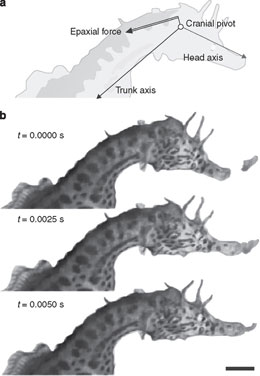Research Abstract
タツノオトシゴ類の馬の首に似た体形を適応によって説明
生体力学的解析によって、タツノオトシゴ類は頭・首・胴部の特異な姿勢のおかげで、ヨウジウオ類に比べて、目の位置からより遠く離れた場所にいる獲物のアミ類を捕獲できることを示す。
An adaptive explanation for the horse-like shape of seahorses
2011年1月25日 Nature Communications 2 : 164 doi: 10.1038/ncomms1168

タツノオトシゴ類は、体形が馬の首から上の部分に似た魚類で、胴部が湾曲し、頭部が腹側にうな垂れ、口吻が細長く伸びている。タツノオトシゴ類は、まっす ぐな体形のヨウジウオ類に似た祖先種から進化した。今回我々は生体力学的解析によって、タツノオトシゴ類は頭・首・胴部の特異な姿勢のおかげで、ヨウジウ オ類に比べて、目の位置からより遠く離れた場所にいる獲物のアミ類を捕獲できることを示す。数理モデル化によって得られたこの結果は、獲物を捕獲するとき のヨウジウオ科魚類(タツノオトシゴ類も含む)の運動学的データによって確認された。つまり、調べたすべてのタツノオトシゴ種では、獲物を捕捉する際の口 吻の移動経路は、まっすぐな体形のヨウジウオ類に比べると一貫して前方に進む成分が大きく、より前方に突き出せることがわかった。このように捕捉の射程距 離が大きくなったことで、獲物を捕捉できる水中範囲は拡大する。このことは特に、タツノオトシゴ類のように尾で体を海藻などに固定して獲物をじっと待つ捕 食者にとって有益である。こうした捕獲の生体力学的特性は選択上有利に働くと推定され、タツノオトシゴ類の胴部が馬に似た形に湾曲していることの説明にな ると考えられる。
タツノオトシゴ類の体形には意味がある (Nature Video) も併せてご覧下さい。
- アントワープ大学(ベルギー)
The body shape of seahorses resembles the head and neck of horses because of their curved trunk, their ventrally bent head and their long snout. Seahorses evolved from ancestral, pipefish-like species, which have a straight body. Here, we use a biomechanical analysis and show that the seahorse’s peculiar head, neck and trunk posture allows for the capture of small shrimps at larger distances from the eyes compared with pipefish. The results from the mathematical modelling were confirmed by kinematic data of prey-capturing syngnathids: compared with straight-bodied pipefish, all seahorse species studied consistently show an additional forward-reaching component in the path travelled by the mouth during their strikes at prey. This increased strike distance enlarges the volume of water they can probe for food, which is especially useful for tail-attached, sit-and-wait predators like seahorses. The biomechanics of prey capture thus provides a putative selective advantage that may explain the bending of the trunk into a horse-like shape.

